In September, a 16 foot long 3,500-pound female great white shark was tagged by researchers off Cape Cod. The shark was nicknamed Mary Lee. Since then Ocearch, the group tracking the shark, have followed Mary Lee on a remarkable journey. The shark swam as far south as Jacksonville Beach, FL in January, causing some alarm as she swam within 200 feet of the beach. Now she has traveled north again and is heading back toward Cape Cod.
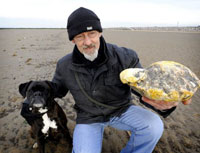
Ken Wilman, his dog Madge and their smelly find Photo:Manchester Evening News
There is some very interesting beachcombing going on these days in the UK. Two weeks ago, we posted about four large, barrel-shaped pieces of lard that washed up on the beach at St.Cyrus nature reserve in Scotland. Locals opined that it smelled “good enough to have a fry up with,” which convinced me never to try fried food in that part of Scotland. Now, Ken Wilman, who was out walking his dog on a beach in Lancashire, found a 6 pound smelly lump of what may be ambergris, the “whale vomit” valued in the manufacturing of perfume. He has been offered £43,000 for the lump by a French dealer, though others have valued it at between £100,000 – 180,000. Thanks to Irwin Bryan for passing the story along.
Dog walker finds smelly lump of whale vomit on beach that’s worth £100,000
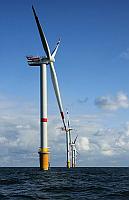 New energy is coming to Fukushima, the region in Japan best known for a nuclear disaster following the Tōhoku earthquake and tsunami of 11 March 2011. The nuclear meltdown at the Fukushima Daiichi was largest nuclear disaster since the Chernobyl meltdown of 1986, and only the second to measure Level 7 on the International Nuclear Event Scale. Now, the world’s largest wind farm is set to begin construction this July, 16 kilometers off the coast of Fukushima. The offshore wind farm will comprise 143 wind turbines capable of generating 1 gigawatt of electrical power. The wind farm is part of Fukushima’s plan to become completely energy self-sufficient by 2040, using renewable sources alone. The prefecture also plans to build Japan’s largest solar energy park.
New energy is coming to Fukushima, the region in Japan best known for a nuclear disaster following the Tōhoku earthquake and tsunami of 11 March 2011. The nuclear meltdown at the Fukushima Daiichi was largest nuclear disaster since the Chernobyl meltdown of 1986, and only the second to measure Level 7 on the International Nuclear Event Scale. Now, the world’s largest wind farm is set to begin construction this July, 16 kilometers off the coast of Fukushima. The offshore wind farm will comprise 143 wind turbines capable of generating 1 gigawatt of electrical power. The wind farm is part of Fukushima’s plan to become completely energy self-sufficient by 2040, using renewable sources alone. The prefecture also plans to build Japan’s largest solar energy park.
The Greater Gabbard farm off the coast of Suffolk, UK is currently the world’s largest offshore wind farm with 140 turbines generating 540 megawatts of power.
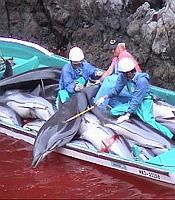 Every year in the village of Taiji, Japan there is a yearly hunt which results in the slaughter of over a thousand dolphins. Despite international protest including a 2009 documentary film, the Cove, which graphically displayed the mass dolphin killing, and won an Academy Award as best Best Documentary Feature in 2010, the yearly slaughter continues. Now approach is being tried. A petition is circulating addressed to Jacques Rogge and the International Olympic Committee requesting that Japan’s Tokyo 2020 Olympic bid not be considered until the Japanese government agrees to end the brutal Taiji dolphin drive hunt and makes it illegal to hunt dolphins in Japan. Click the link below to learn more and to sign the petition. It costs nothing and may do considerable good. Thanks to Scott Powell for passing the word along.
Every year in the village of Taiji, Japan there is a yearly hunt which results in the slaughter of over a thousand dolphins. Despite international protest including a 2009 documentary film, the Cove, which graphically displayed the mass dolphin killing, and won an Academy Award as best Best Documentary Feature in 2010, the yearly slaughter continues. Now approach is being tried. A petition is circulating addressed to Jacques Rogge and the International Olympic Committee requesting that Japan’s Tokyo 2020 Olympic bid not be considered until the Japanese government agrees to end the brutal Taiji dolphin drive hunt and makes it illegal to hunt dolphins in Japan. Click the link below to learn more and to sign the petition. It costs nothing and may do considerable good. Thanks to Scott Powell for passing the word along.
PETITION: Challenge Japan to END Taiji Dolphin Hunt for Tokyo 2020 Olympic bid
 The Navy has announced that the minesweeper, USS Guardian, which ran up on Tubbataha reef in the Philippines Sula Sea two weeks ago, will be cut up in place and hauled away. The reason given is that the approach will “involve the least damage to the Tubbataha Reef.” They had previously determined that the fiberglass sheathed wooden ship was too damaged to float if towed off the reef. Depending on the availability of crane vessels, the Navy may have had no other choice.
The Navy has announced that the minesweeper, USS Guardian, which ran up on Tubbataha reef in the Philippines Sula Sea two weeks ago, will be cut up in place and hauled away. The reason given is that the approach will “involve the least damage to the Tubbataha Reef.” They had previously determined that the fiberglass sheathed wooden ship was too damaged to float if towed off the reef. Depending on the availability of crane vessels, the Navy may have had no other choice.
All indications are that the electronic charts had the reef miss-plotted by roughly eight nautical miles. The larger question, however, is what the minesweeper was doing so close to the reef which is part of the Philippines’ Tubbataha National Marine Park and a designated World Heritage Site. Reportedly, the ship was warned that it was in protected area and that it was approaching the reef, but apparently ignored the warnings. Thus far the grounding is reported to have damaged around 1,000 square meters of coral reef or about 1% of the reef withing the park. Philippine President Benigno Aquino III is demanding an explanation as to why the ship grounded onthe reef.
The Hawaiian surfer Garrett McNamara is said to have broken his own world record for the largest wave surfed when he caught a wave reported to be around 100ft off the coast of Nazaré, Portugal. McNamara set the previous record in 2011 also off Nazaré.
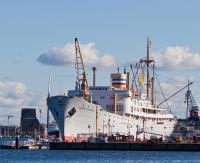 In its more than 60 year history, the MS Georg Büchner, ex-Charlesville, served in liner service between Belgium and the Belgian Congo and Angola, was a DDR training ship and for the last decade was a hotel and youth hostel in the German city of Rostock. As the Charlesville, she was one of the ships to answer the call to rescue the passengers on the burning passenger liner Laconia in 1963.
In its more than 60 year history, the MS Georg Büchner, ex-Charlesville, served in liner service between Belgium and the Belgian Congo and Angola, was a DDR training ship and for the last decade was a hotel and youth hostel in the German city of Rostock. As the Charlesville, she was one of the ships to answer the call to rescue the passengers on the burning passenger liner Laconia in 1963.
Despite protests that the ship should be saved, the Georg Büchner may soon be towed from its current berth in Rostock to a scrap yard in Lithuania. The remaining obstacle to scrapping may be the local Heritage Commission which must give its final approval. In the mean time, various proposals are being prepared to save the ship, including moving her to Belgium. Thanks to Mary Habstritt of the Lilac Preservation Project for passing along the news.
 The Confederate submarine H.L. Hunley is credited as the first successful submarine, in that it was the first submarine to sink an enemy warship in combat. New findings, however, might cause some to reconsider this “success.” The Hunley may have been sunk by the force of its own explosive mine.
The Confederate submarine H.L. Hunley is credited as the first successful submarine, in that it was the first submarine to sink an enemy warship in combat. New findings, however, might cause some to reconsider this “success.” The Hunley may have been sunk by the force of its own explosive mine.
The H.L. Hunley sank the USS Housatonic on the night of February 17, 1864 at the entrance to Charleston, South Carolina harbor. The Hunley never returned from the attack on the Union ship. The Hunley carried a single 135 pound gunpowder explosive on a 16′ spar on its bow. It was long thought that the Hunley hooked the explosive on the Housatonic with a grappling hook then backed away before the explosive detonated. Recent analysis of the spar, however, suggests that the explosive was bolted to the end of the spar itself and that the detonation took place with the Hunley less than 20 feet from its target. The explosion, at that close range, could have also knocked the crew of the Hunley unconscious, leading to their deaths by suffocation.
The Hunley turned out to be a killing machine, but it killed mostly Confederates. In training and on its one mission, the submarine killed 21 Confederate officers and sailors, including its namesake, H.L. Hunley. In the attack on the Housatonic, a total of five Union officers and sailors died. Thanks to Phil Leon for contributing to this post.
Experts: Confederate sub near target at sinking (See also our previous post – Civil War Confederate Submarine H.L. Hunley Unveiled.)
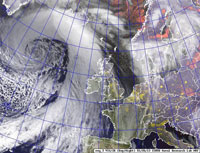
Photo: Navy Research Lab, Monterey.
Last Saturday, in the Northern Atlantic to the south of Iceland, the extratropical storm Jolle, intensified dramatically. Meteorologists use central pressure as a proxy for measuring the strength of a given storm. The lower the barometric pressure, the more intense the storm. By this standard, Jolle, whose central pressure dropped to slightly below 930 mb, was more intense than Superstorm Sandy, which dropped to a pressure of 940 mb. Fortunately, the storm Jolle did not strike land. The old expression to describe storms as moving “safely out to sea,” has never set very well with mariners, but one hopes that in these days of weather routing that most ships avoided Jolle.
The all time record for lowest barometric pressure for a North Atlantic extratropical storm is 913 mb, set on January 11, 1993. During that storm, the 90,000 dwt tanker Braer was caught out in the storm. Piping on deck broke allowing saltwater to enter the fuel tanks, disabling the engine and causing the ship to drift onto Garths Ness on the Shetland Islands, resulting in a significant oil spill.
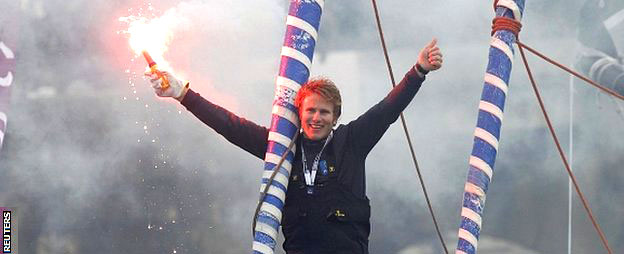 François Gabart, sailing MACIF, won the Vendée Globe round-the-world single-handed race in 78 days and two hours, shattering the previous record of 84 days and three hours, set in 2009 by Michel Desjoyeaux. Ending what has been a round-the-world match-race between the two fastest boats, Armel Le Cléac’h, sailing Banque Populaire, crossed the finish line a mere 3 hours 17 minutes 12 seconds behind Gabart, to claim second place. This is the closest finish between the first and second place boats in the history of the Vendée Globe.
François Gabart, sailing MACIF, won the Vendée Globe round-the-world single-handed race in 78 days and two hours, shattering the previous record of 84 days and three hours, set in 2009 by Michel Desjoyeaux. Ending what has been a round-the-world match-race between the two fastest boats, Armel Le Cléac’h, sailing Banque Populaire, crossed the finish line a mere 3 hours 17 minutes 12 seconds behind Gabart, to claim second place. This is the closest finish between the first and second place boats in the history of the Vendée Globe.
Britain’s Alex Thomson, sailing Hugo Boss, is expected to arrive on Monday or Tuesday to claim third place. After Jean-Pierre Dick lost his keel in the north Atlantic last week, Thomson diverted to offer assistance. Dick has remained in the race and is currently in fourth place. The remaining fleet of eight boats range from Jean Le Cam, sailing SynerCiel, who is roughly 2,500 NM from the finish line to Alessandro Di Benedetto, on Team Plastique, who still has around 4,700 NM to sail.
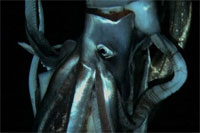 Tomorrow, January 27th, at 8 PM ET & PT, the Discovery Channel is airing Monster Squid: The Giant is Real featuring the first video ever recorded of a live giant squid in its natural habitat. (See our recent post Giant Squid Filmed for First Time in the Deep Sea.)
Tomorrow, January 27th, at 8 PM ET & PT, the Discovery Channel is airing Monster Squid: The Giant is Real featuring the first video ever recorded of a live giant squid in its natural habitat. (See our recent post Giant Squid Filmed for First Time in the Deep Sea.)
In addition to their great size, approaching fifty feet, the giant squid and its slightly larger relative, the colossal squid, each have the largest eyes of any animals for their size. Scientists have been puzzled by this. Why would a creature that lives in almost total darkness need eyes the size of basketballs? Even stranger, the eyes, collected from dead giant squids, do not appear to be very good at seeing any sort of detail. What is the evolutionary point?
Researchers built a mathematical model to get an idea what a giant squid could see through these huge and strange eyes. They determined that the squid is extremely far-sighted. Nothing up close would be very clear. About the only thing that the eyes would be good for is seeing large shapes at a distance. Which is, of course, exactly what the giant squid needs. Its primary predator is the sperm whale, the toothed leviathan large enough to battle the razor sharp suckers of the giant squid. It appears that giant squid have “super-sperm-whale-vision.”
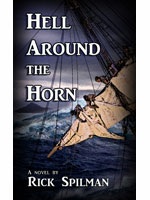 A wonderful review of ‘Hell Around the Horn‘ in the Navy Fiction blog.
A wonderful review of ‘Hell Around the Horn‘ in the Navy Fiction blog.
I thoroughly enjoyed this novel by Rick Spilman – actually his debut novel! Spilman knows ships and the sea. He has worked as a naval architect and is an avid sailor. He has also sailed as volunteer crew on the replica square-riggers “HMS Rose” and “HMS Bounty,” and much more. Even though he doesn’t overstate it, his vast knowledge shows. Hell Around the Horn is also very well written; the characters are interesting and very much alive; and the story is based on historical facts. Hell Around the Horn had me racing through the story. Even without naval battles and taller-than-life naval heroes, this book really is a page turner. It is highly recommended!
 François Gabart sailing MCIF in the Vendée Globe is less than 700 miles from the finish line, 76 days after setting out in the singled-handed around-the-world race. Armel Le Cléac´h sailing Banque Populaire is roughly one hundred miles behind Gabart. The third place contender, Jean-Pierre Dick on Virbac Paprec 3, is still determining whether or not he will be able to finish the race. Three days ago, the articulating keel on his boat broke off and since then he has been relying on water ballast for stability. On a recent video broadcast he commented, ‘I’d go faster if I had a keel.’ Alex Thomson sailing Hugo Black in fourth place is standing by to assist Dick is necessary.
François Gabart sailing MCIF in the Vendée Globe is less than 700 miles from the finish line, 76 days after setting out in the singled-handed around-the-world race. Armel Le Cléac´h sailing Banque Populaire is roughly one hundred miles behind Gabart. The third place contender, Jean-Pierre Dick on Virbac Paprec 3, is still determining whether or not he will be able to finish the race. Three days ago, the articulating keel on his boat broke off and since then he has been relying on water ballast for stability. On a recent video broadcast he commented, ‘I’d go faster if I had a keel.’ Alex Thomson sailing Hugo Black in fourth place is standing by to assist Dick is necessary.
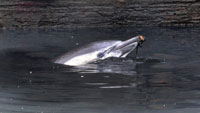
Photo: AP / Richard Drew
Update: Dolphin Dies in Gowanus Canal
Crowds of onlookers gathered today in the bitter cold on the Union Street Bridge to see an apparently injured dolphin stuck in shallow water in New York’s Gowanus Canal. The canal is one of the most polluted areas in New York harbor due to a combination of industrial and sewage discharges, including heavy metals and other toxins. The canal has recently been declared a Superfund Site. NYPD Harbor and Emergency Service units are on the scene as are marine biologists from the Riverhead Foundation. Right now they are waiting for high tide at 7PM this evening in hopes that the dolphin is capable of swimming out of the canal on its own. Thanks to Phil Leon for contributing to the post.
The continued frigid weather has compelled the folks at the Brooklyn Lyceum to cancel the first shanty sing scheduled for tomorrow night. Apparently the heating system in the 3,600-square-foot brick-lined theater with cavernous ceilings, is not up to the bitterly cold weather that we are experiencing here in New York. The shanty sing will be rescheduled.
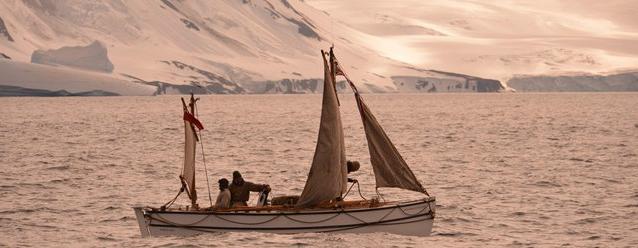
Photo: Shackleton Epic
In the Antarctic winter of 1916, Ernest Shackleton and a crew of five sailed in a decked over lifeboat from Elephant Island to South Georgia. They were on a desperate rescue mission across 800 miles of the roughest ocean in the world, seeking help for the rest of the crew of the Shackleton’s expedition, which had spent two years on the Antarctic ice. Now almost 100 years later, the Shackleton Epic Expedition led by Tim Jarvis has set off from near Point Wild on Elephant Island to recreate the extraordinary voyage in a replica lifeboat, named the Alexandra Shackleton, in honor of the explorer’s granddaughter. See our previous post from last March.
Adventurers recreate ‘greatest survival story’ of the Antarctic
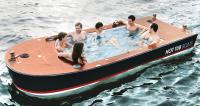 Only on rare occasional does one find a boat that would be significantly improved if run hard aground. Here is one example, however. Many large yachts have hot tubs onboard. This 16′ boat, however, is simply a floating hot tub with a diesel-powered boiler to keep the water hot, an electric motor for propulsion, a sound system and four coolers for beverages (of course.) I wonder where the PFDs are stored. Why this nautical accident-waiting-to-happen is in any way superior to a dock-side hot tub is not clear to me. With luck it would never leave the dock. Available at Hammacher Schlemmer for a price of $42,000.
Only on rare occasional does one find a boat that would be significantly improved if run hard aground. Here is one example, however. Many large yachts have hot tubs onboard. This 16′ boat, however, is simply a floating hot tub with a diesel-powered boiler to keep the water hot, an electric motor for propulsion, a sound system and four coolers for beverages (of course.) I wonder where the PFDs are stored. Why this nautical accident-waiting-to-happen is in any way superior to a dock-side hot tub is not clear to me. With luck it would never leave the dock. Available at Hammacher Schlemmer for a price of $42,000.
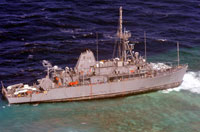
Photo:ARMED FORCES OF THE PHILIPPINES
The minesweeper USS Guardian ran aground on a reef at the Tubbataha marine park in the Sula Sea last Thursday. The ship is still there. So far there has been no reported leaks of fuel leaks though the Navy has confirmed that multiple spaces aboard the ship have been flooded. The worsen weather may threaten the salvage of the ship. The north east monsoon winds known as the Amihan are expected to worsen over the next few days.
As reported by GMA News: “The strong northeasterly wind and the associated big waves could affect any operation to rescue the US vessel. One thing to consider is there is another surge of the northeast monsoon this week, so expect stronger winds and heavier seas,” GMA News’ resident meteorologist Nathaniel “Mang Tani” Cruz said.
Time running out for USS Guardian in Tubbataha as Amihan winds intensify
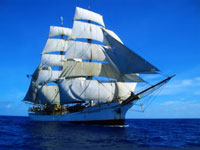
Barque Picton Castle
Happy Bounty Day! On Pitcairn Island, Bounty Day is celebrated yearly on January 23, in commemoration of the burning of the HMS Bounty by the mutineers in 1790. The sail training ship Picton Castle arrived just in time to partake in the celebrations. From the Captain’s Log/Facebook:
All hands were woken at 0700 to sail past Adamstown, Pitcairn Island. At 0810 we anchored off Tedside in light conditions, with 3 shots of chain out in 10 fathoms of water, concluding a 25 day passage from the Galapagos. Hello Pitcairn! We made it to Pitcairn just in time to celebrate Bounty Day – looking forward to sharing in the festivities! Happy Bounty Day to all!
The Picton Castle is a three masted steel barque operating as sail training vessel currently on a South Pacific voyage. After transiting the Panama canal the Picton Castle sailed for the Galapagos and then on to Pitcairn. The voyage will take the ship to French Polynesia, onward through the Cook islands with stops in Tonga and Samoa before ending in Rarotonga.
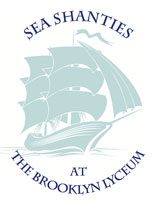 This Friday, January 25th, from 8 to 10PM, a waterfront tradition will be returning to Brooklyn. The first of planned monthly shanty sings will be held at the Brooklyn Lyceum. All lovers of the music of the sea are welcome. This Friday’s session is being held in memory of Howie Leifer, who recently died of cancer. Howie was long-time member of the sea shanty community in New York, as well as a wonderful entertainer and gifted puppeteer.
This Friday, January 25th, from 8 to 10PM, a waterfront tradition will be returning to Brooklyn. The first of planned monthly shanty sings will be held at the Brooklyn Lyceum. All lovers of the music of the sea are welcome. This Friday’s session is being held in memory of Howie Leifer, who recently died of cancer. Howie was long-time member of the sea shanty community in New York, as well as a wonderful entertainer and gifted puppeteer.
The Brooklyn Lyceum is at 227 4th Avenue on the corner of President Street, in Brooklyn, New York. Accessible by subway on the R train to Union Street. Hot chocolate and mulled wine will be served to help keep away the cold. Cost: $5.00
